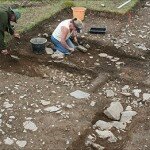Historic Roman Finds Go On Display
 A number of Roman artefacts found by archaeologists near Aberystwyth are to go on display this month.
A number of Roman artefacts found by archaeologists near Aberystwyth are to go on display this month.
The artefacts were discovered at a site in Abermagwr, where an old Roman Villa was discovered.
A number of the most impressive finds will be going on display to the public at the Ceredigion Museum in Aberystwyth.
The discoveries were made in the July of 2010 by Ex Aberystwyth University Professor Jeffrey Davies and Dr Toby Driver of the Royal Commission on the Ancient and Historical Monuments of Wales.
As well as being able to see the artefacts, archaeologists will be giving a number of talks about the finds on display, so that you can find out a bit more about them too!
The villa itself was discovered after a number of aerial photographs, and studies of the area confirm that it was occupied during the 3rd and 4th centuries. The winged villa was located within a rectangular area, surrounded by a double ditch. It is the most north westerly roman villa ever to be discovered in Wales, and probably belonged to wealthy landowners or traders.
Pre dig research carried out in 2008 allowed researches to identify a building with 3 distinct rooms, and a veranda which faced south. Researches were at this time unable to say what type of building it was, and theories ranged from a ritual fort from the iron age, to a church or chapel. A roman villa was also considered as an option, with a prominent Roman settlement known to be at Pennal near Machynlleth.
It may suprise you however to know that the site was first spotted from the air 1979 by Cambridge University. However, research only began in 2006 when a severe drought by Welsh standards revealed the full layout of the enclosure and the building. Up until this point the spot had never been investigated because of its unusual shape.
The villa proved to be typical of late roman villas in Wales and Southern England, with slate roof tiles which had been finely carved to create a decorative roof, which consisted of locally sourced materials. The stone for the walls was also locally sourced and sat on a cobble base. It is not know whether or not the villa had two floors, but if it did it is more likely that these were built from timber frames and plaster.
The roof itself was found to have collapsed, and underneath it was hiding a small number of minted coins from Constantine I. It was the minting date relating to these coins which helped the researchers to date the villa. The coins were minted in Lyon in France, London and Trier in Germany. Also found were a number of bowls and kitchen wares imported to the area from Dorest and Oxfordshire.
The home was pillaged of its stone during the medieval period, leaving only the floor and the discovered artefacts behinds. Over time, the land was ploughed until the villa was a distant memory. Ironically, the Welsh word Magwr in the towns name translates as ‘ruined homestead’….
There is little to see at the site itself, however don’t miss your chance to see this fantastic exhibition! The exhibition opens up on 11th December at midday.


